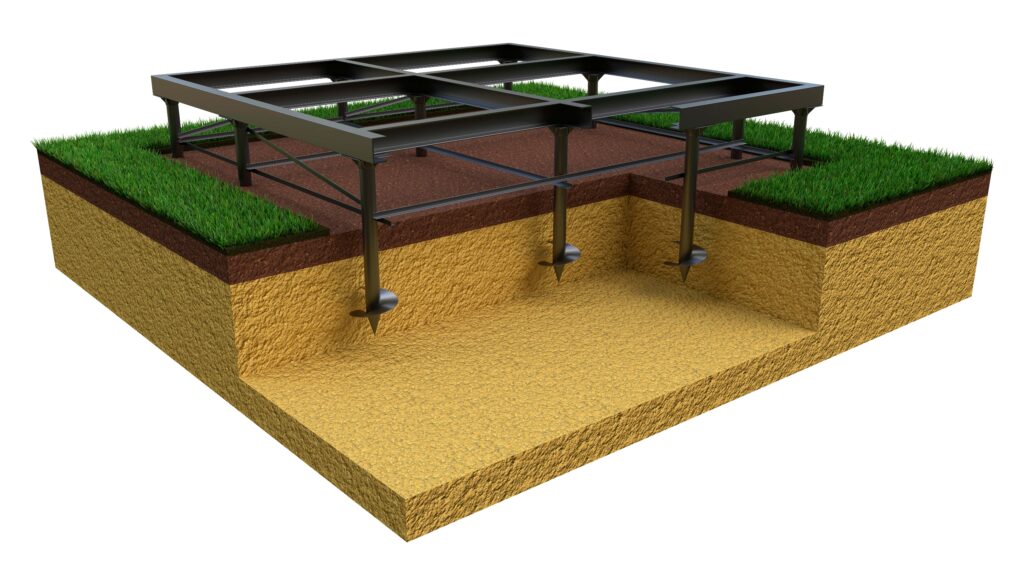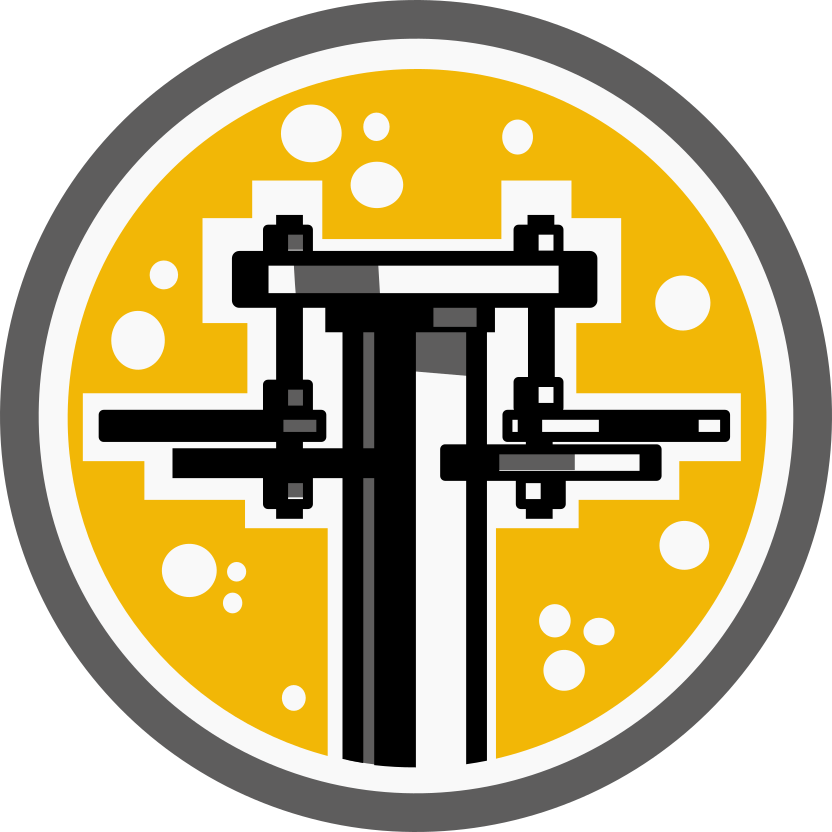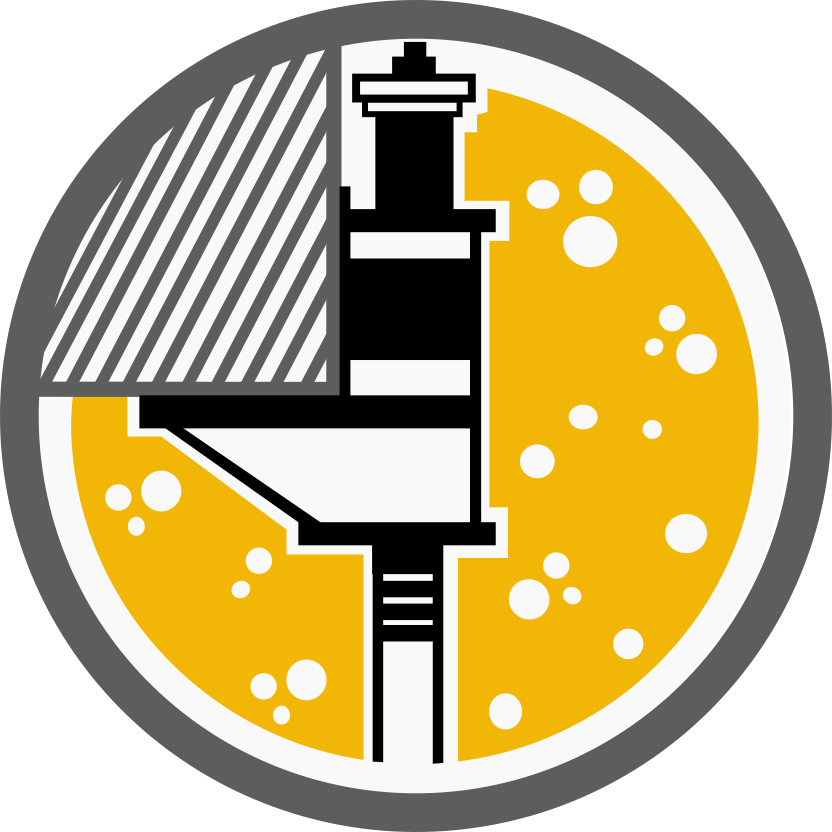New York’s Expert Guide to Helical Piers and Foundation Support
Our expertise in soil conditions, foundation repair, and helical pier installation ensures that your property receives the highest quality care. In this expert guide to helical piers, we’ll go over everything you need to know about helical piers: from how they work and their benefits to the installation process and costs. Whether you’re facing immediate foundation problems or simply want to future-proof your property, this resource will help you better understand what helical piers have to offer.
Ready to Take the Next Step? Contact Us Today for a Free Consultation and Learn How Helical Piers Can Strengthen Your Foundation and Protect Your Investment.
What Are Helical Piers?
Helical piers are foundation elements designed to provide support for structures by transferring the load to deeper, more stable soil layers. They consist of high-strength steel shafts with one or more helical plates welded to the shaft, resembling large screws. These plates allow the piers to be screwed into the ground using hydraulic machinery, which, when installed correctly provide a secure and stable foundation.
Helical piers are used in both residential and commercial applications. In residential settings, they support new homes, extensions, and repairs to existing foundations. In commercial projects, they stabilize office buildings, retail spaces, industrial facilities, and other structures. The installation process is quick and causes minimal site disturbance, making helical piers ideal for projects where maintaining the integrity of the surrounding area is critical.

How Do Helical Piers Work?
Helical piers are like the superheroes of the construction world, providing vital support to foundations in need. They are screwed in next to your foundation, deep enough to reach more stable strata, then cut to the appropriate length and connected to your foundation with a steel plate. This process provides a strong and reliable support system for structures, ensuring stability even in challenging soil conditions.
Here’s a step-by-step explanation to give you a clear mental image of how they work:
- Installation Next to the Foundation: Imagine a helical pier as a giant screw. The process begins with positioning the helical pier next to your existing foundation. Specialized equipment is used to hold and guide the pier as it starts its downward journey.
- Screwed Down into More Stable Strata: Now comes the fun part—screwing the pier into the ground! The helical pier is twisted into the soil, much like a corkscrew being driven into a wine bottle. This action continues until the pier reaches a more stable layer of soil or bedrock. This stable layer is what gives the pier its strength, allowing it to support your foundation effectively.
- Cut Off at the Foundation Level: Once the pier has reached the desired depth, any excess length of the pier is cut off at the foundation level. This ensures that the top of the pier is flush with the bottom of your foundation, creating a seamless support system.
- Connected to the Foundation with a Steel Plate: The final step involves anchoring the pier to your existing foundation. A robust steel plate is used to connect the top of the helical pier to the foundation. This connection ensures that the load from the structure is transferred efficiently down through the pier and into the stable strata below.
What Are Helical Piers Used For?
Helical piers are used in numerous applications, ranging from residential foundation repair to supporting commercial structures. Their primary function is to transfer the load from a structure to deeper, more stable soil layers, providing a solid and secure foundation.
- Home Foundations
- Commercial Properties
- New Construction
- Docks and Wharfs
- Retaining Walls
- Elevated Structures
- Decks, and Pools
By understanding the diverse uses of helical piers, property owners can choose the right application for their specific needs, ensuring stability and longevity for their structures.
Benefits of Helical Piers for Foundation Support
Helical piers offer several benefits for home and business owners looking to make their properties more resilient and ensure long-term stability. One of the primary benefits is their ability to provide immediate load-bearing capacity, making them ideal for projects with tight timelines. Additionally, their installation process is minimally invasive, reducing disturbance to the surrounding area and existing structures.
Here is a list of the benefits of helical piers for foundation support:
- Immediate Load-Bearing Capacity
- Minimally Invasive Installation
- Versatility For Various Applications
- Stability and Longevity Of Foundations
- Cost-Effective Solution
Get Best-in-Class Service Every Time Backed by a Solid 30-Year Warranty. Choose Piers and Piles for Your Residential or Commercial Project Today!

Types of Helical Pier Systems
When it comes to providing reliable support in construction, helical pier systems offer a versatile, efficient, and cost-effective solution for stabilizing and reinforcing structures. These systems are particularly useful in areas with unstable or shifting soil conditions, ensuring long-term stability and safety.
Here are the three main types of helical pier systems—helical piles, helical piers, and helical tiebacks and anchors.
Helical Piers:
Helical piers support and stabilize existing foundations that have shifted or settled. They are driven deep into stable soil, making them ideal for foundation repair and underpinning with minimal disturbance and precise installation.

Helical Piles
Helical piles support new construction or repairs, ideal for poor soil conditions by transferring the load to stable ground. They offer quick installation, minimal excavation, and immediate load-bearing capacity.

Helical Tiebacks and Anchors:
Helical tiebacks and anchors provide lateral support for retaining and basement walls. Installed horizontally, they help prevent soil erosion and wall collapse, offering quick installation and strong reinforcement.
Helical Piers Installation Process
The installation of helical piers begins with a site assessment to determine the ideal location and depth for each pier. Using specialized hydraulic machinery, the piers are screwed into the ground until they reach a stable soil layer or bedrock that can support the load.
As the piers are installed, their torque and depth are carefully monitored to ensure optimal load-bearing capacity. Once in place, the piers are connected to the building’s foundation or structural elements to provide immediate support and stabilization.
This process is efficient, requires minimal excavation, and can be completed quickly, even in confined spaces or areas with difficult soil conditions.
Here is the step by step helical piers installation process:
- Site Assessment: Evaluating soil conditions and determining the appropriate pile size and depth.
- Installation: Using hydraulic machinery to screw the piers into the ground.
- Load Testing: Ensuring the piers meet the required load-bearing capacity.
- Foundation Attachment: Connecting the piers to the structure’s foundation.
How Much Do Helical Piers Cost?
When budgeting for helical pier installation, it’s important to understand the cost. Typically, prices range between $30 to $60 per foot, depending on factors like soil conditions, the type of pier, and installation complexity. While the per foot price is a key factor, the total project cost also includes expenses like labor, equipment, mobilization, and the depth needed to reach stable soil. For deeper installations, the per foot pricing becomes more significant, but it’s important to remember that site-specific conditions and engineering requirements can still affect the overall cost.
If you’re planning a project in Brooklyn, Queens, or Long Island, NY, and you would like a more precise estimate tailored to your property, contact us today. Our team of certified experts is ready to provide you with a custom quote and guide you through the next steps. Get a clear, straightforward breakdown of what to expect and ensure your foundation is built on a stable, reliable solution.
How Many Helical Piers Do I Need?
The number of helical piers required for a project is indeed dependent on several key factors, and it is important to check local building codes to determine specific spacing and load-bearing requirements. For example, national standards often specify that the minimum spacing between the centerlines of helical piers should be at least four times the diameter of the largest helix plate. In New York, building codes follow these general guidelines to ensure proper load distribution and structural stability.
- Soil Conditions: The strength and composition of the soil directly impact the load-bearing capacity of the helical piers.
- Project Size and Weight: Larger structures or heavier loads necessitate more piers for adequate support.
- Specific Engineering Calculations: Soil testing and load calculations provide precise data to determine the optimal number and placement of piers.
This information is crucial for homeowners and contractors to understand that the number of helical piers is not a one-size-fits-all solution. Compliance with local regulations is essential to ensure safe and effective pier installation. According to New York Building Code section 1814.10, the minimum spacing between the centerlines of helical piers shall be four times the largest helix plate diameter. This requirement ensures adequate load transfer and prevents the piles from interacting negatively with each other.
To learn more about determining how many helical piers you need for your project, check out our blog on, “How Many Helical Piers Do I Need for My Project“.
How Deep Do Helical Piers Go?
The depth at which helical piers are installed can vary significantly based on the specific requirements of the project and the soil conditions at the site. Generally, helical piers are driven into the ground until they reach stable, load-bearing soil layers, which can range from 10 to 60 feet deep or more. Factors such as the type of structure being supported, the weight load, and the characteristics of the underlying soil all influence the required depth. Professional assessment and proper installation are crucial to determine the optimal depth for ensuring the long-term stability and effectiveness of the foundation.
How Long Do Helical Piers Last?
Helical piers are known for their durability and long lifespan, often lasting as long as the structure they support. Made from high-quality steel and designed to withstand various soil conditions, helical piers provide a stable and reliable foundation solution. The longevity of helical piers can be influenced by factors such as soil conditions, installation quality, and environmental exposure. With proper installation and maintenance, helical piers can effectively support a structure for decades, offering a long-term solution to foundation issues.
| Criteria | Push Piers | Helical Piers |
|---|---|---|
| Installation | Driven into the ground using the weight of the structure to push the piers into stable soil layers. | Screwed into the ground using hydraulic machinery with helical plates anchoring the pier securely into stable soil. |
| Ideal Conditions | Best for heavier buildings where the structure's weight can drive the piers into the ground and where deep, stable soil is present. | Suitable for a variety of soil conditions, including soft or loose soils; applicable for both new construction and existing structures. |
| Advantages | Effective for underpinning and lifting settled foundations with minimal disturbance to the structure. | Immediate load-bearing capacity, quick installation, minimal site disturbance, and adaptable to various project needs. |
| Method of Installation | Relies on the structure's weight. | Uses a screw-like motion with hydraulic machinery. |
| Versatility | Less versatile, depending on the structure's weight and soil conditions. | Highly versatile and suitable for a wider range of soil conditions. |
| Load-Bearing Capacity | Excellent load-bearing capacity, ideal for specific conditions. | Also offers excellent load-bearing capacity, adaptable to different needs. |
Push Piers vs Helical Piers: What's the Difference?
When considering foundation support and repair options, it’s important to understand the differences between push piers and helical piers to determine which solution best fits your needs. Both push piers and helical piers are effective methods for stabilizing and lifting foundations, but they differ in installation techniques, ideal conditions, and overall versatility. Each type offers unique benefits that can address specific structural challenges, depending on factors like soil conditions and the weight of the structure.
The table above provides a detailed comparison of push piers and helical piers, highlighting their installation processes, ideal applications, and key advantages. Understanding these differences will help homeowners and contractors make informed decisions when choosing the most suitable foundation repair method for their project.
Expert Guide to Helical Piers for Foundation Support: Final Thoughts
In conclusion, helical piers offer a reliable and efficient solution for foundation support across various applications. Their versatility, quick installation, and minimal site disturbance make them an ideal choice for both residential and commercial projects. Whether you are dealing with challenging soil conditions or need a fast, robust foundation solution, helical piers provide the necessary support to ensure the stability and longevity of your structure.
Ready to Secure Your Foundation with Helical Piers? Contact Us for a Free Inspection!